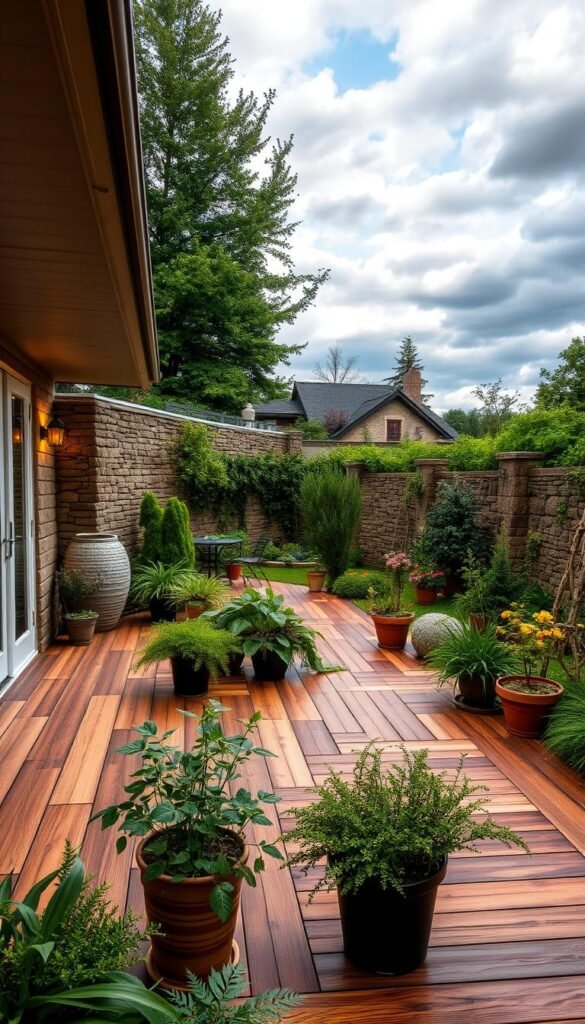Your backyard holds endless potential to become a cherished retreat. With smart design choices, you can craft an outdoor living space that feels like a natural extension of your home. This guide reveals practical yet stylish approaches to elevate your property’s appeal while boosting its value.
Discover how to blend comfort with nature through layouts that suit any yard size. Whether you’re hosting summer barbecues or enjoying quiet mornings with coffee, these concepts help create distinct zones for every activity. Materials range from budget-friendly composites to luxurious hardwoods, ensuring options for all preferences.
Learn to avoid common mistakes like poor drainage or mismatched color schemes. We’ll show you how to combine textures and patterns for visual harmony while maintaining easy upkeep. Imagine stepping outside to a personalized oasis where functionality meets relaxation – that dream is closer than you think.
From cozy fire pit areas to elevated dining platforms, each suggestion focuses on maximizing usability without sacrificing style. These adaptable solutions work equally well in urban courtyards and sprawling suburban gardens. Let’s explore how to turn your underused plot into a destination you’ll never want to leave.
Embracing Your Garden’s Potential for Outdoor Living
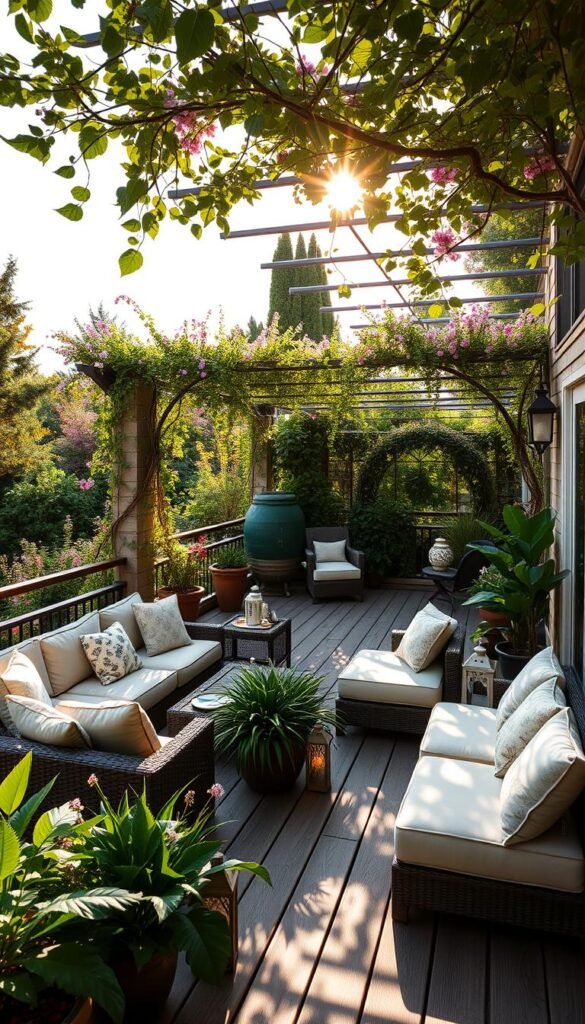
Your garden’s true value lies in its ability to become an outdoor room that mirrors your home’s comfort. Think beyond basic seating – this space can host dinners, yoga sessions, or even weekend movie nights. With smart planning, you’ll create zones that adapt to your needs as effortlessly as your kitchen or living room.
A well-designed deck acts as your summer command center. Picture mornings with coffee surrounded by potted herbs, then evenings hosting friends under string lights. The secret? Treat this living space like an interior designer would – layer textures, define pathways, and choose durable materials that age gracefully.
Even compact gardens shine when you maximize vertical space. Floating shelves for plants or foldable furniture keeps areas multifunctional. Built-in benches with hidden storage? They’re game-changers for small footprints.
The magic happens when your deck feels like part of your home. Match your interior color palette outside, or repeat architectural details like railings. Suddenly, grilling burgers becomes as natural as cooking indoors – just with better views.
By viewing your garden through this lens, you’ll craft an outdoor living experience that’s uniquely yours. It’s not about size – it’s about intention. Every square foot can tell your story while making memories under open skies.
12 Decking Ideas for Creating Inviting Garden Patios
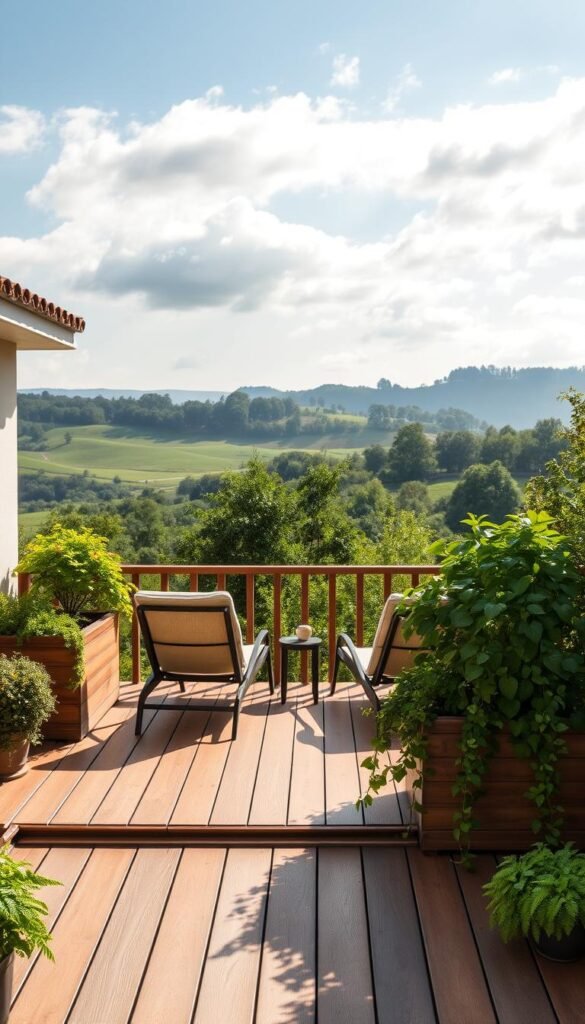
Unlock your outdoor space’s hidden possibilities with transformative deck ideas that reshape how you experience nature. These concepts blend practicality with creativity, offering solutions for both cozy corners and expansive entertaining zones. From sunken seating areas to modular platforms, each approach prioritizes comfort while celebrating your landscape’s unique features.
Material mixing creates visual depth in any patio layout. Pair weather-resistant composite boards with natural stone accents for a tactile contrast that withstands seasons. For smaller yards, tiered designs add dimension without overwhelming the space – perfect for defining separate lounging and dining areas.
Consider integrating built-in planters or recessed lighting to design a multifunctional retreat. These elements extend usability into evening hours while fostering a seamless indoor-outdoor connection. If you’re drawn to contemporary styles, geometric patterns in decking boards offer clean lines that complement modern architecture.
Your patio should reflect how you live. A curved platform softens angular landscapes, while mixed-width boards add subtle movement underfoot. For those seeking inspiration, our guide to elevate your gardening aesthetic pairs beautifully with these structural concepts.
These adaptable deck ideas prove that great design solves problems while sparking joy. Whether adding a floating bench or experimenting with border details, each choice builds toward an outdoor sanctuary that feels intentionally yours. The best spaces invite you to linger longer, breathe deeper, and reconnect with what matters most.
Designing a Deck That Blends Indoor Comfort With Outdoor Charm
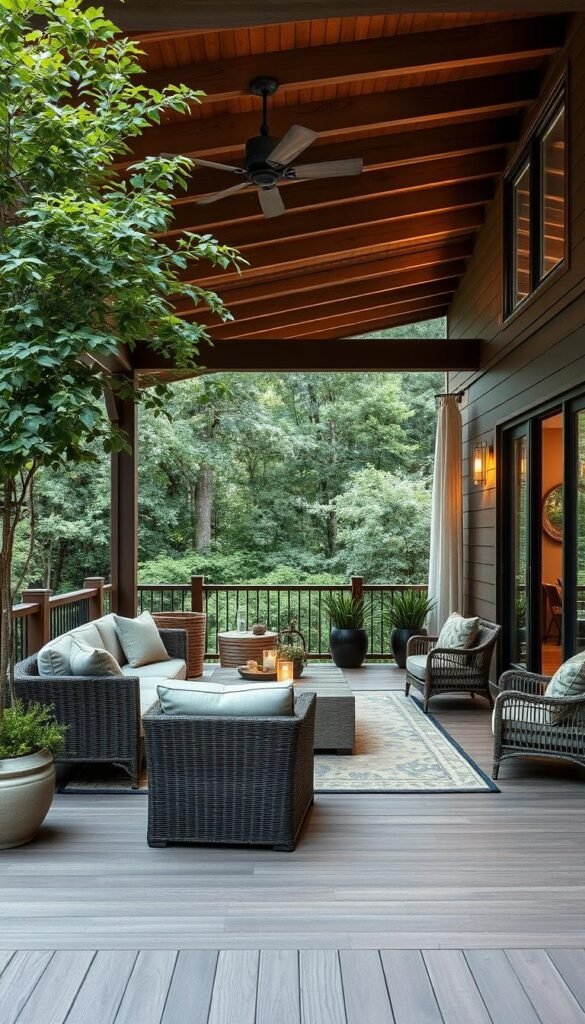
Your outdoor space becomes a true sanctuary when it mirrors the coziness of your interiors. Start by considering how textures underfoot and overhead structures can create that “second living room” feel. Landscape experts at Yardzen note:
“Regional design is about forging relationships with the natural world around your home – creating spaces that thrive within local ecosystems.”
Selecting the Right Materials for Lasting Beauty
Local stone and composite boards work wonders for climate-smart design. Wood remains a favorite for its barefoot-friendly warmth, but modern alternatives like capped composites offer similar appeal with less upkeep. Match your home’s architecture – farmhouse styles sing with wide-plank cedar, while urban spaces pop with sleek porcelain tiles.
Incorporating Color, Texture, and Style
Pull color inspiration from your interior throw pillows or artwork. A gray-stained deck might echo your kitchen counters, while terracotta planters could mirror living room accents. For timeless appeal, try mixing vintage and modern elements through patterned railings or mixed-material benches.
Remember: sun exposure affects how materials age. A north-facing space? Embrace darker stains that hide moisture. South-facing? Lighter tones prevent scorching. Your choices today shape tomorrow’s outdoor living experience – make them count.
Incorporating Privacy and Natural Elements Into Your Deck
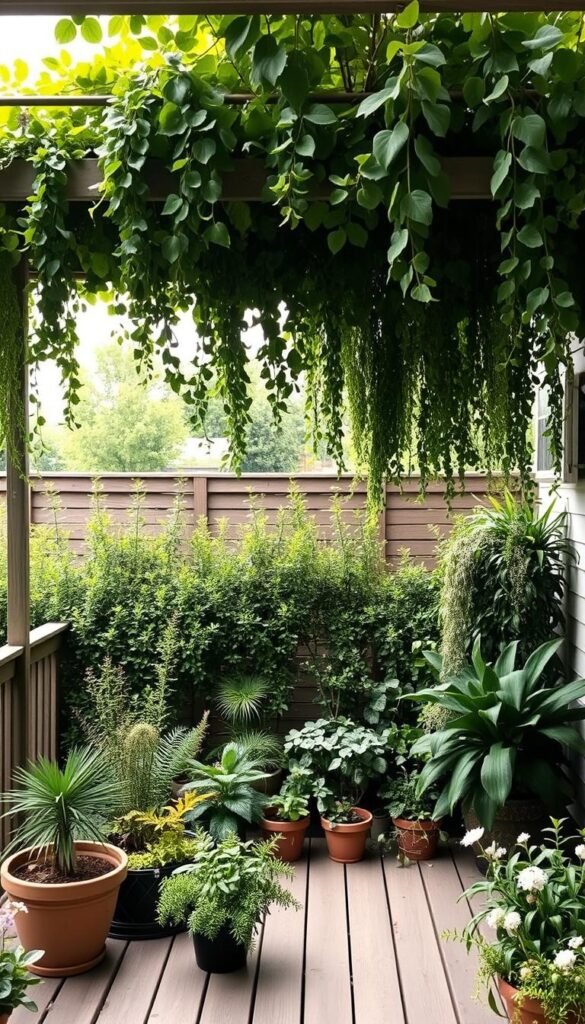
City living often means trading privacy for convenience, but your deck area doesn’t have to feel exposed. Recent studies show a 22% surge in homeowners adding seclusion features – proof that personal retreats matter more than ever. The solution? Blend functional screening with nature’s artistry.
Layered Planting: Your Living Privacy Screen
Think beyond basic hedges. Combine tall evergreens, mid-height grasses, and flowering vines to create depth. This approach offers year-round coverage while attracting pollinators. For quick results, try fast-growing options like arborvitae or clumping bamboo in planters.
Stone Accents That Ground Your Design
Local stone brings earthy texture to your space. Use slate slabs as stepping stones or stack flat rocks into low walls. These elements pair beautifully with wood decking, creating contrast that feels intentional. Pro tip: Match stone colors to your home’s exterior for cohesion.
| Stone Type | Best Use | Maintenance |
|---|---|---|
| Slate | Pathways | Low |
| Limestone | Retaining Walls | Moderate |
| Granite | Decorative Borders | None |
For a whimsical touch, tuck mossy stones between pavers or create a cottagecore aesthetic with creeping thyme. Remember: Privacy isn’t about hiding – it’s about crafting an intimate space where you can unwind completely.
Maximizing Views and Creating Inviting Focal Points
Your deck’s layout can completely transform how you experience your outdoor space. Position it to frame your garden’s standout features – maybe a blooming cherry tree or a sculptural boulder. Deck designer Clare Matthews notes:
“Even modest yards have hidden gems. Angle seating toward that special spot where sunlight dances through leaves at golden hour.”
Elevated platforms give a great way to see your garden from fresh angles. Imagine sipping morning coffee while overlooking flower beds or watching fireflies from a raised lounge area. Track sun patterns through seasons – place benches where autumn colors glow brightest or summer shade lingers longest.
No mountain vistas? Borrow neighboring charm. Frame a distant church spire with climbing roses or align your deck to highlight a friend’s stunning maple. Strategic gaps in fencing can turn a neighbor’s garden into your extended view.
Create instant focal points with architectural elements. A circular fire pit becomes a gathering hub, while vertical trellises guide eyes upward. Matthews suggests: “Use materials that age beautifully – weathered teak benches or copper planters develop character that pulls the look together naturally.”
Wabi-Sabi Aesthetics: Embracing the Beauty of Imperfection
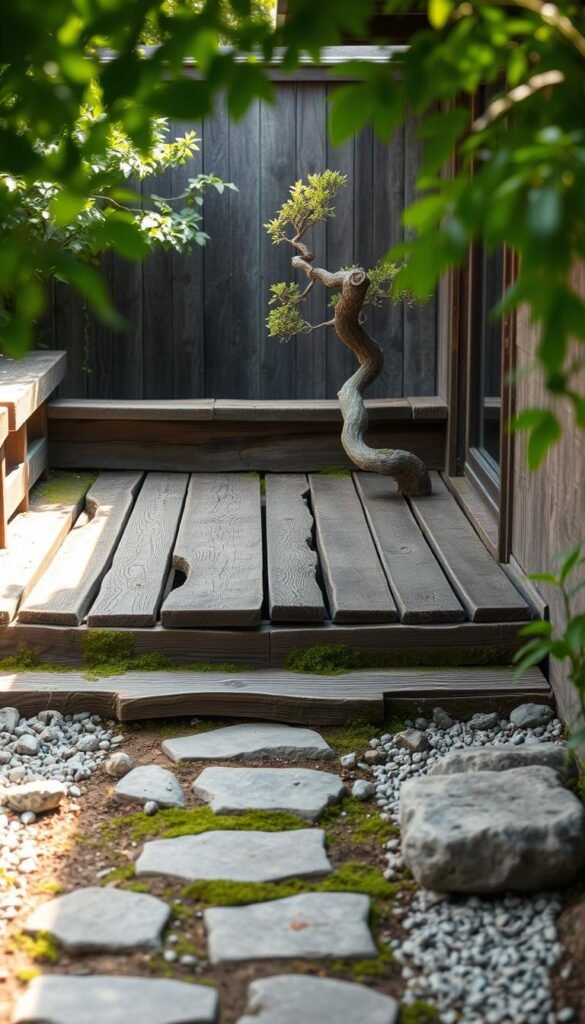
What if your deck’s cracks and weathering told a story instead of signaling repairs? This Japanese philosophy finds magic in nature’s gradual transformations. Let your outdoor space become a canvas where time collaborates with materials.
Celebrating Weathered Wood and Natural Aging
Untreated cedar or redwood develops silvery patinas that feel like whispered secrets from the elements. Each knot and grain variation becomes a badge of honor. This approach works beautifully with design styles ranging from coastal cottages to minimalist urban retreats.
Skip the annual staining ritual. Rain and sun create organic patterns no brush can replicate. Watch how morning dew highlights unique textures in your wood planks – these fleeting moments embody wabi-sabi’s transient beauty.
Letting Nature Enhance Your Deck’s Character
Moss creeping between boards? Celebrate it as living decor. Allow climbing vines to frame your seating area naturally. This style thrives in spaces where plants and structures coexist without rigid boundaries.
Over time, your deck becomes a diary of seasons. Winter frost etches delicate patterns. Summer sun bleaches specific boards. These changes create depth that prefab materials can’t match. Your space evolves into a testament to nature’s artistry – imperfectly perfect.
Smart Layouts for Multi-Purpose Deck Spaces
Transform your outdoor deck into a dynamic hub that shifts with your daily rhythm. Landscape expert Simon Parry advises:
“When planning a deck, start by thinking how you want to use the space throughout the day. Build zones around those moments.”
Zoning for Dining, Lounging, and Activities
Create distinct areas that serve different needs without visual clutter. A sunken conversation pit can coexist with raised dining platforms, separated by strategic planters. Use materials to signal transitions – try composite boards for high-traffic zones and smooth stone for relaxation spots.
| Zone Type | Key Features | Material Suggestions |
|---|---|---|
| Dining | Weather-resistant table, overhead lighting | Composite decking |
| Lounge | Deep seating, side tables | Teak or stone accents |
| Activity | Open floor space, storage benches | Stamped concrete |
Garden Design Stories’ Sari Lampinen recommends: “Size your deck 10-15% larger than initial plans. That extra breathing room prevents the ‘sardine effect’ during gatherings.” Keep pathways at least 36 inches wide for smooth traffic flow between zones.
Rotate furniture seasonally – lightweight bistro sets for summer mornings, plush sectionals for autumn evenings. Your living space outdoors should feel as adaptable as your favorite indoor room, ready for anything from yoga sessions to birthday bashes.
Innovative Circular and Split-Level Deck Designs
Break free from boxy layouts with curves and elevation changes that redefine outdoor living. These fresh approaches to deck design create natural gathering spots while adding architectural intrigue to your yard.
Benefits of a Circular Deck Concept
Curved edges soften hardscapes and foster connection. Neil Sutcliffe of Creative Roots shares: “The brief was evening relaxation around a fire pit – circles naturally draw people together.” Opt for durable woods like Ipe, which weathers to a soft silver, blending organically with nature.
Design Considerations for a Split-Level Layout
Bi-level decks solve multiple needs in one space. Alex Bluedorn notes: “Upper platforms catch sun, while lower shaded areas stay cool – it’s a great way to maximize usage.” Connect zones with wide steps that double as casual seating. For inspiration on tiered layouts, explore split-level patio concepts that balance form and function.
Unify different levels using matching materials and strategic lighting. Vertical planters or cascading herbs can visually link spaces. Discover creative gardening solutions that enhance these dynamic designs, proving smart layouts make every square foot count.

